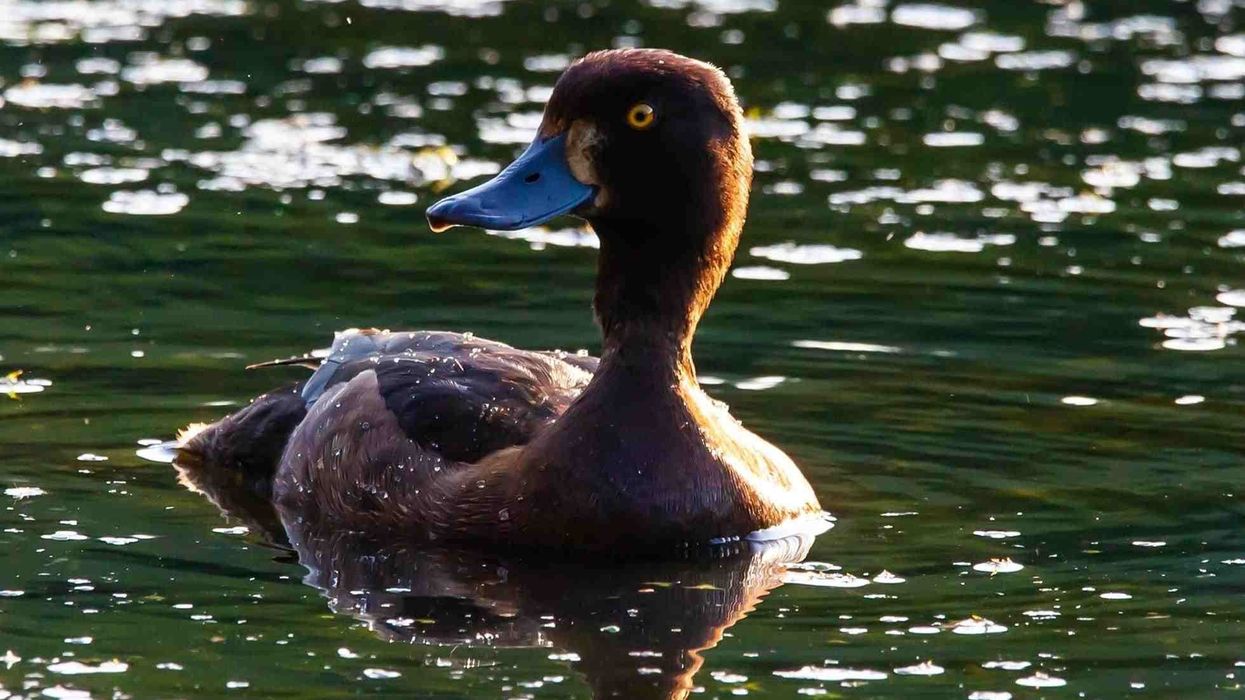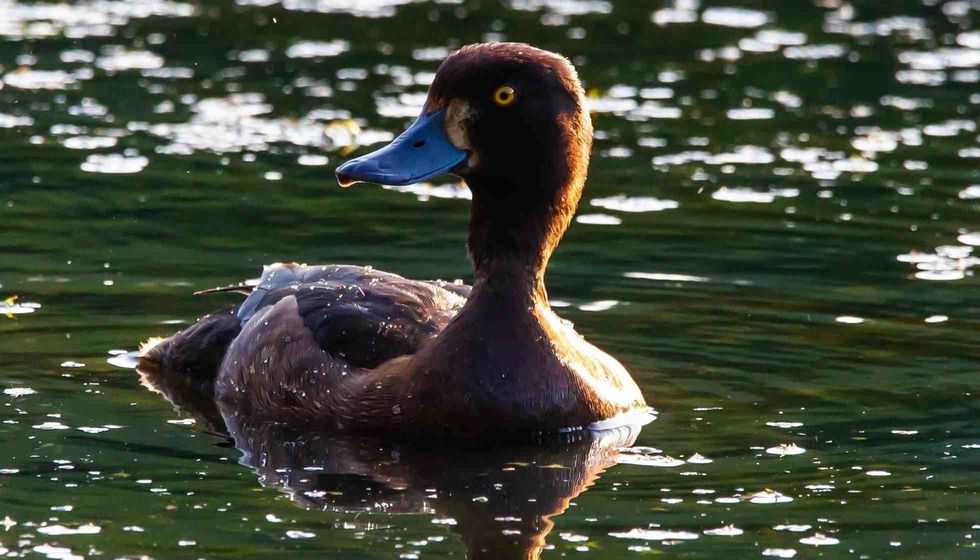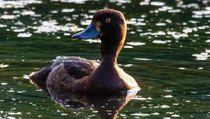Fun Diving Duck Facts For Kids

With various species of aquatic birds living in freshwaters and sea, diving ducks are one of them. They are also known as sea ducks, dabblers, and divers.
Diving duck species are closely related to dabbling ducks, although diving ducks do not walk on land, unlike dabbling ducks. Found in coastal areas, the long-tailed duck, scoter, ruddy duck, goldeneye, bufflehead, eider, ring-necked duck, scaup, and merganser are referred to as North American diving ducks.
The ducks feed through diving deep into the surface of coast water and sea. The sea ducks are gregarious, while northern species migrate unlike the southern.
The marbled duck (Marmaronetta angustirostris) from genus Marmaronetta, red-crested pochard (Netta rufina), southern pochard (Netta erythrophthalma), and rosy-billed pochard (Netta peposaca) from genus Netta, and canvasbacks (Aythya valisineria), common pochard (Aythya ferina), redhead (Aythya americana), ring-necked duck (Aythya collaris), hardhead (Aythya australis), Baer's pochard (Aythya baeri), ferruginous duck (Aythya nyroca), Madagascar pochard (Aythya innotata), reunion pochard (Aythya cf.
innotata), New Zealand scaup (Aythya novaeseelandiae), tufted duck (Aythya fuligula), greater scaup (Aythya marila), and lesser scaup (Aythya affinis) from genus Aythna are some ducks belonging to the subfamily of diving ducks (Aythyini).
Precisely, snifftails (ruddy duck), sea ducks (eiders, scoters, mergansers, goldeneyes, buffleheads, long-tailed ducks), and pochards (ring-necked ducks, canvasbacks, scaup, redheads) are among the three distinct genera of North American waterfowl.
Read on to learn all about them.
If the uniqueness of the diving duck makes you interested to read more about similar species, you can read about carrion crow and house wren.
Diving Duck Interesting Facts
What type of animal is a diving duck?
Diving ducks, also North American waterfowl, are web-footed aquatic birds that are efficient swimmers and divers, living underwater. They are also known as scaup or pochard. They are closely related to dabbling sucks.
What class of animal does a diving duck belong to?
Diving ducks belong to class Aves, the family Anatidae, and the tribe Aythyini. They are a part of a large family including ducks, geese, and swans.
How many diving ducks are there in the world?
While the population of diving ducks is undeciphered, it is speculated to be common species found either underwater or on the surface of the water.
Where does a diving duck live?
A diving duck is native to the northern hemisphere of the globe. The three distinct tribes of diving ducks among the waterfowl are located in North America. It is often recorded in Europe, Asia, and as far as Africa. While the northern species migrate, southern species of ducks remain loyal to their habitat.
What is a diving duck's habitat?
A diving duck prefers freshwaters. The ducks dive deep beneath the surface of the water in search of food and feed on various aquatic creatures. They do not move on lands, and they only use their feet to move underwater. They prefer to stay either underwater or on the surface of the water while avoiding terrestrial habitats.
Who do diving ducks live with?
Diving ducks are gregarious species of birds, often found living in flocks of birds. The group of ducks is also known as rafts. The northern species of birds migrate in groups, unlike the southern species of ducks.
How long does a diving duck live?
The lifespan of the diving duck is poorly studied and understood. On the other hand, a female long-tailed duck lives at least for 17 years. Furthermore, a female mallard duck is reported to be the longest living species of duck.
How do they reproduce?
The breeding season of the birds is reported to commence post their migratory period. Mostly, diving ducks are recorded to return in breeding pairs, but there are a few unpaired ducks.
The breeding region of diving ducks varies from one species of subfamily to other. While the breeding region of canvasbacks ranges from the Prairie pothole region to as far as the north of Alaska, the ring-necked ducks breed across the forests of Canada.
Also, while scaup birds build nests on the land, canvasbacks create floating nests over the surface of the water.
Diving ducks are oviparous animals, i.e. they lay eggs and eggs hatch into ducklings which further grow into mature ducks.
What is their conservation status?
While the conservation status of diving ducks is Not Evaluated under the IUCN Red List of Threatened Species, reports are documented highlighting a decline in their population.
Diving Duck Fun Facts
What do diving ducks look like?
There are considerable similarities among the species of the family of diving ducks, and they can be differentiated with their distinctive features.
A ring-necked duck is a common duck in the winter season. It has dark gray and black plumage with a chestnut brown ring on its nape. The bill of the ring-necked is gray with a black and white tip.
The lesser scaup is very similar to a ring-necked duck, it has a gray bill with a peaked head which has a purple iridescence in light.
Similarly, the greater scaup is identical to the lesser scaup. It has a round head with green iridescence. It is a quite prominent duck in winter.
The redhead, on the other hand, has a cinnamon brown colored head, unlike the dark green head of greater scaup.
The canvasback has a similar brown-colored head to that of a redhead, it has a large black bill with bright red eyes.
The bufflehead is a small black and white duck with a black head having striking rainbow iridescence.
On the other hand, a ruddy duck, a small brown diving duck, has a sky blue bill and a short tail. During the breeding season, the birds have a red-brown plumage, while they are noticed to have dark gray-brown plumage with white cheeks.
The common goldeneye is dimorphic, i.e. male birds and female birds differ from each other based on their appearance. It is a medium-sized duck with black and white plumage and golden eyes. While the male has a dark green head with white spots, the female duck is reported to have a brown head but lacks white spots.
A long-tailed duck is mostly spotted in the winter season. The male is black with a white blotch on his face in the summer, while the long-tailed male is white with brown, black, and gray blotches on his face.
On the other hand, females and ducklings have brown and white plumage. The long-tailed male has a long and slender tail irrespective of its plumage, the hen lacks a long-sized tail.
The hooded merganser is a dimorphic bird and the smallest among mergansers. While a male has brown underparts, a black back, and a head with a large white blotch, the female duck is brown with a crested head.
Contrarily, the red-breasted merganser is an uncommon bird showing dimorphism, i.e. male ducks have distinctive characteristics from females. The male has a red-brown breast with a dark green head. On the other hand, females are gray-brown. It has white bands on its wings with a white ring on its neck.
The common merganser is the largest merganser and it too portrays dimorphism with the male and female birds reflecting distinctive characteristics. The male is white with a black back, dark green head, and a red bill. On the contrary, a female is white and gray with a brown head.
Commonly, the ducks have feathered wings of colors varying from black, brown, gray, and white. Also, the ducks have webbed feet to dive and swim in waters.

How cute are they?
With ranging colors from white, black, brown, gray, with distinctive iridescences, the diving ducks are some of the cutest species of birds.
How do they communicate?
The ducks are known to quack; they are loud with a softer voice. While different species of ducks use various methods to communicate, they usually use vocalizations and body language to communicate with one other.
How big is a diving duck?
While species of diving ducks vary in size, the diving duck is 19-20 in (48.2-51 cm) long on average. A wandering albatross is the largest aquatic bird recorded so far, which is twice the size of the diving ducks.
How fast can a diving duck fly?
A diving duck has big webbed feet and legs are set back on its torso. While the flying speed of the diving ducks remains unknown, they are recorded to dive as deep up to 1.5-6 ft (0.4-1.8 m).
How much does a diving duck weigh?
Considering the size of the ducks, a diving duck is a lightweight bird weighing from 2-2.5 lb (0.9-1.1 kg).
What are the male and female names of the species?
A male duck is often called a drake, while a female is known as a hen.
What would you call a baby diving duck?
A baby duck or young small diving duck is called a duckling or chick.
What do they eat?
The diving ducks feed on a variety of food such as aquatic plants, seeds, fish, crustaceans, and invertebrates. Their feeding habits differ from one species to another. For instance, the long-tailed ducks feed upon invertebrates and small fish.
Are they dangerous?
While ducks are gregarious in nature and often are recorded to portray cruel and violent temperament. However, they are mostly harmless possessing no danger.
Would they make a good pet?
A diving duck is best left in its natural habitat, feeding on its desired food and preying underwater. There are no speculations recorded about its behavior among humans.
Did you know...
The diving ducks are quite active during the winter season.
While the divers have distinct features, they too have considerable similarities – prominently the webbed feet and common habitat.
A diving duck has a strong powerful taste. It is also reported to taste like a liver. Its taste can be masked using extra preparation making it delicious.
A long-tailed duck is the deepest diving duck. It is spotted in the winter season. The species is known to have distinctive plumage during the winter, compared to summer. It can dive up to 200 ft (61 m).
A duck can dive up to 1.5-6 ft (0.4-1.8 m). While a duck dives within 10-30 seconds, a diving duck can stay underwater for more than a minute. It can also dive even deeper beneath the surface of the water.
Naming the diving duck
The species of ducks are known as diving ducks because they are good divers, diving beneath the surface of the water, and prefer staying underwater.
What ducks are considered divers?
Diving ducks have three genera: Netta, Marmaronetta, and Aythya. Some species of diving ducks are scoters, ruddy duck, eiders, buffleheads, mergansers, goldeneyes, scaup, long-tailed ducks, canvasbacks, redheads, and ring-necked ducks. Diving ducks have webbed feet to assist them in aquatic habitats.
Here at Kidadl, we have carefully created lots of interesting family-friendly animal facts for everyone to discover! Learn more about some other birds from our myna facts and coal tit facts for kids.
You can even occupy yourself at home by coloring in one of our free printable diving duck coloring pages.
We Want Your Photos!
More for You
See All
Bachelor of Arts specializing in Economics

Gurpuneet KaurBachelor of Arts specializing in Economics
As a skilled content writer, Gurpuneet has written and managed engaging content for multiple websites and companies. Driven by a passion for helping young people achieve their full potential, she brings a unique perspective to her work. She is currently pursuing a degree in Economics from Sri Guru Gobind Singh College Of Commerce. With extensive experience as a tutor, Gurpuneet has made a significant impact by providing guidance and academic support to students. Her dedication extends beyond tutoring as she has volunteered with Action India, where she offered medical assistance and educational aid to underprivileged communities. Additionally, Gurpuneet has contributed to the creation of student study guides for various educational agencies.
Bachelor of Commerce specializing in Marketing and HR

Pradhanya RaoBachelor of Commerce specializing in Marketing and HR
With a Bachelor’s degree in Commerce from Christ University, Bangalore, Pradhanya's passion for the English language and literature led her to explore the field of content writing, where she has gained extensive experience in writing, reviewing, editing, and fact-checking. She has also earned certifications in Google Ads Search, Google Ads Display, and Social Media Marketing, showcasing her proficiency in digital marketing.
Disclaimer
1) Kidadl is independent and to make our service free to you the reader we are supported by advertising. We hope you love our recommendations for products and services! What we suggest is selected independently by the Kidadl team. If you purchase using the Buy Now button we may earn a small commission. This does not influence our choices. Prices are correct and items are available at the time the article was published but we cannot guarantee that on the time of reading. Please note that Kidadl is a participant in the Amazon Services LLC Associates Program, an affiliate advertising program designed to provide a means for sites to earn advertising fees by advertising and linking to Amazon. We also link to other websites, but are not responsible for their content.
2) At Kidadl, we strive to recommend the very best activities and events. We will always aim to give you accurate information at the date of publication - however, information does change, so it’s important you do your own research, double-check and make the decision that is right for your family. We recognise that not all activities and ideas are appropriate for all children and families or in all circumstances. Our recommended activities are based on age but these are a guide. We recommend that these ideas are used as inspiration, that ideas are undertaken with appropriate adult supervision, and that each adult uses their own discretion and knowledge of their children to consider the safety and suitability. Kidadl cannot accept liability for the execution of these ideas, and parental supervision is advised at all times, as safety is paramount. Anyone using the information provided by Kidadl does so at their own risk and we can not accept liability if things go wrong.
3) Because we are an educational resource, we have quotes and facts about a range of historical and modern figures. We do not endorse the actions of or rhetoric of all the people included in these collections, but we think they are important for growing minds to learn about under the guidance of parents or guardians.







